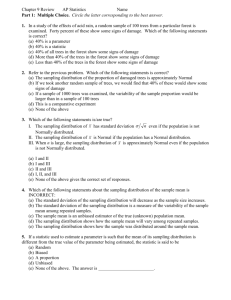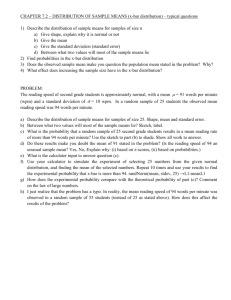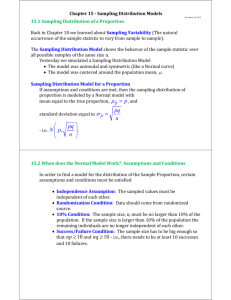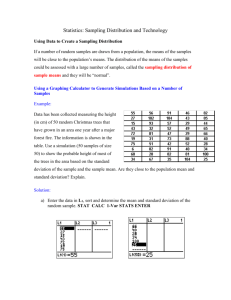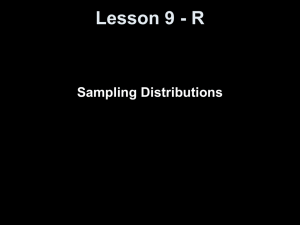Test 9C - AHS - Mrs. Hetherington
advertisement
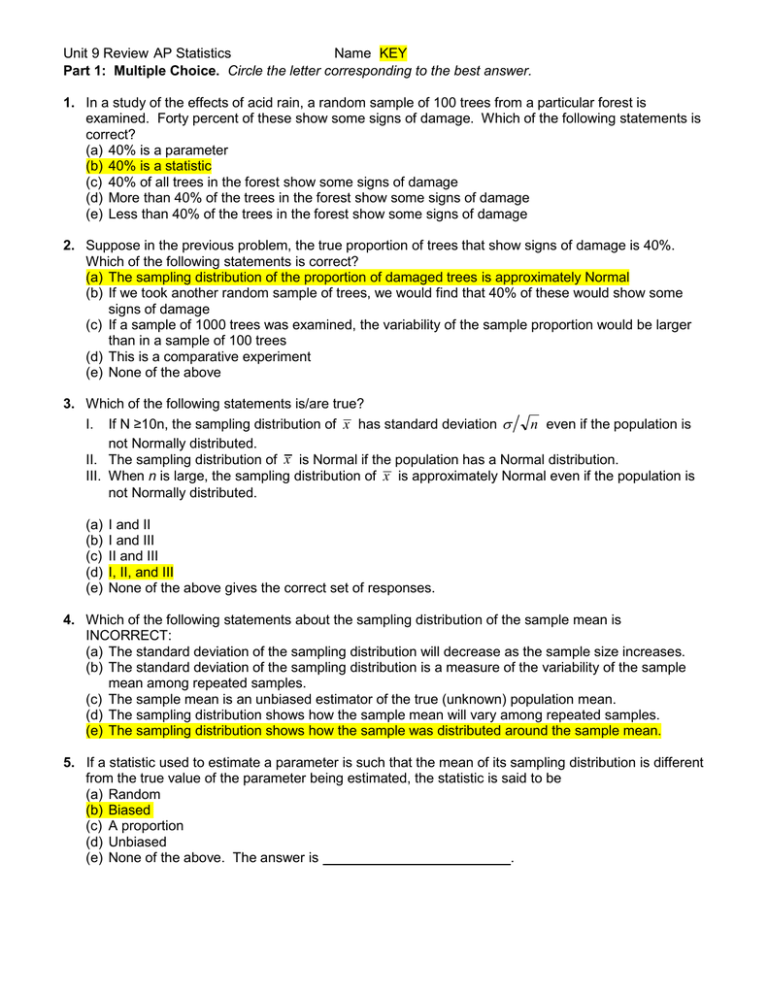
Unit 9 Review AP Statistics Name KEY Part 1: Multiple Choice. Circle the letter corresponding to the best answer. 1. In a study of the effects of acid rain, a random sample of 100 trees from a particular forest is examined. Forty percent of these show some signs of damage. Which of the following statements is correct? (a) 40% is a parameter (b) 40% is a statistic (c) 40% of all trees in the forest show some signs of damage (d) More than 40% of the trees in the forest show some signs of damage (e) Less than 40% of the trees in the forest show some signs of damage 2. Suppose in the previous problem, the true proportion of trees that show signs of damage is 40%. Which of the following statements is correct? (a) The sampling distribution of the proportion of damaged trees is approximately Normal (b) If we took another random sample of trees, we would find that 40% of these would show some signs of damage (c) If a sample of 1000 trees was examined, the variability of the sample proportion would be larger than in a sample of 100 trees (d) This is a comparative experiment (e) None of the above 3. Which of the following statements is/are true? I. If N ≥10n, the sampling distribution of x has standard deviation n even if the population is not Normally distributed. II. The sampling distribution of x is Normal if the population has a Normal distribution. III. When n is large, the sampling distribution of x is approximately Normal even if the population is not Normally distributed. (a) (b) (c) (d) (e) I and II I and III II and III I, II, and III None of the above gives the correct set of responses. 4. Which of the following statements about the sampling distribution of the sample mean is INCORRECT: (a) The standard deviation of the sampling distribution will decrease as the sample size increases. (b) The standard deviation of the sampling distribution is a measure of the variability of the sample mean among repeated samples. (c) The sample mean is an unbiased estimator of the true (unknown) population mean. (d) The sampling distribution shows how the sample mean will vary among repeated samples. (e) The sampling distribution shows how the sample was distributed around the sample mean. 5. If a statistic used to estimate a parameter is such that the mean of its sampling distribution is different from the true value of the parameter being estimated, the statistic is said to be (a) Random (b) Biased (c) A proportion (d) Unbiased (e) None of the above. The answer is . 6. A machine is designed to fill 16-ounce bottles of shampoo. When the machine is working properly, the mean amount poured into the bottles is 16.05 ounces with a standard deviation of 0.1 ounce. If four bottles are randomly selected each hour and the number of ounces in each bottle is measured, then 95% of the observations should occur in which interval? (a) 16.05 and 16.15 ounces (b) –0.30 and +0.30 ounces (c) 15.95 and 16.15 ounces (d) 15.90 and 16.20 ounces (e) None of the above 7. Dr. Stats plans to toss a fair coin 10,000 times in the hope that it will lead him to a deeper understanding of the laws of probability. Which of the following statements is true? (a) It is unlikely that Dr. Stats will get more than 5000 heads. (b) Whenever Dr. Stats gets a string of 15 tails in a row, it becomes more likely that the next toss will be a head. (c) The fraction of tosses resulting in heads should be close to 1/2. (d) The chance that the 100th toss will be a head depends somewhat on the results of the first 99 tosses. (e) All of the above statements are true. Part 2: Free Response Communicate your thinking clearly and completely. 8. The following window shows the results of a computer simulation that is designed to illustrate sampling distributions. Briefly discuss the bias and variability of the sampling distribution of the sample median. In repeated trials for n = 25, the mean of sample medians centers on the population median. For n = 2, the mean of Sample medians is lower than the population median. This means there is higher bias in the distribution with smaller sample size. Overall, the variability of the sampling distribution of sample medians decreases as sample size increases (from 1 to 2 to 25). 9. In a test for ESP (extrasensory perception), the experimenter looks at cards that are hidden from the subject. Each card contains either a star, a circle, a wave, or a square. As the experimenter looks at each of 20 cards in turn, the subject names the shape on the card. (a) Describe the design of a simulation to estimate the proportion of correct guesses assuming the subject does not have ESP using the partial random digits table below. Then perform the simulation. ONE POSSIBLE SOLUTION: Since the probability of a correct guess is ¼, let 00 – 24 represent correct guesses and 25 – 99 are incorrect guesses. For the first 20 two-digit numbers, count the ones that are “correct guesses.” Make the sample proportion by dividing this number by 20. Repeat this process for several trials. 3 5 4 7 6 6 0 9 4 0 5 5 9 7 2 7 2 0 2 4 3 9 4 2 1 1 7 8 6 8 6 5 8 5 0 2 4 9 4 3 0 4 2 6 6 6 1 7 9 0 3 5 4 3 5 9 0 6 5 6 Stop here for trial #1, p-hat=5/20 When the ESP study described above discovers a subject whose performance appears to be better than guessing, the study continues at greater length. The experimenter looks at many cards bearing one of five shapes (star, square, circle, wave, and cross) in an order determined by random numbers. The subject cannot see the experimenter as he looks at each card in turn, in order to avoid any possible nonverbal clues. The answers of a subject who does not have ESP should be independent observations, each with probability 1/5 of success. We record 1000 attempts. (b) What are the mean and standard deviation of the proportion of successes among the 1000 attempts? σ p-hat = µ p-hat = p = 0.2 √ (.2)(.8) 1000 = 0.0126 (c) Find the probability that a subject without ESP will be successful in at least 24% of the 1000 attempts. Show your work. P (p-hat ≥ .24) = P (z ≥ 3.16) = 0.0008 DRAW THE GRAPH AND LABEL THE MEAN AND ST. DEV. AND SHADE TO THE RIGHT OF P-HAT =.24 (d) The researcher considers evidence of ESP to be a proportion of successes so large that there is only probability 0.01 that a subject could do this well or better by guessing. What proportion of successes must a subject have to meet this standard? THIS QUESTION IS ASKING YOU TO FIND THE P-HAT THAT YIELDS AN AREA OF .01 TO THE RIGHT. BE SURE TO DRAW THE GRAPH OF THE NORMAL CURVE WITH THE MEAN OF P-HAT, STANDARD DEVIATION OF P-HAT AND SHADED AREA NOTED ON THE GRAPH!! SOLUTION #1: FIND THE Z SCORE THAT CORRESPONDS TO .01 ON THE Z TABLE = 2.33 2.33 p hat 0.20 .0126 P hat = .229 OR SOLUTION #2: USE THE CALCULATOR INVNORM(.01, 20, .0126) = .229 10. The amount that households pay service providers for access to the Internet varies quite a bit, but the mean monthly fee is $28 and the standard deviation is $10. The distribution is not Normal: many households pay about $10 for limited dial-up access or about $30 for unlimited dial-up access, but some pay much more for faster connections. (a) Can you determine the probability that the amount a randomly selected household pays for access to the Internet exceeds $29? If so, do it. If not, explain why not. NO, the population is not normal and the sample size is too small (n = 1) to use the Central Limit Theorem. A sample survey asks an SRS of 500 households with Internet access how much they pay and calculates the mean x . (b) What are the mean and standard deviation of the sampling distribution of x ? MU OF X-BAR = MU = 28 SIGMA OF X-BAR = 10 √500 = 0.4472 (c) What is the shape of the sampling distribution of x ? Justify your answer. ALTHOUGH THE SHAPE OF THE POPULATION IS SKEWED RIGHT, THE SHAPE OF THE SAMPLING DISTRIBUTION OF X-BAR IS APPROXIMATELY NORMAL. THIS IS BECAUSE THE SAMPLE SIZE IS LARGE (n = 500), THEREFORE THE CENTRAL LIMIT THEOREM APPLIES. (d) Find the probability that the average fee paid by the sample of households exceeds $29. Show your work. BE SURE TO DRAW THE NORMAL CURVE WITH MU OF X-BAR = 28, SIGMA OF X-BAR = .4472, AND THE AREA SHADED TO THE RIGHT OF 29 CLEARLY LABELED!! P(X-BAR ≥ 29) = P(Z≥2.236) = .0127 (OR .0125 IF YOU USE THE Z TABLE)
